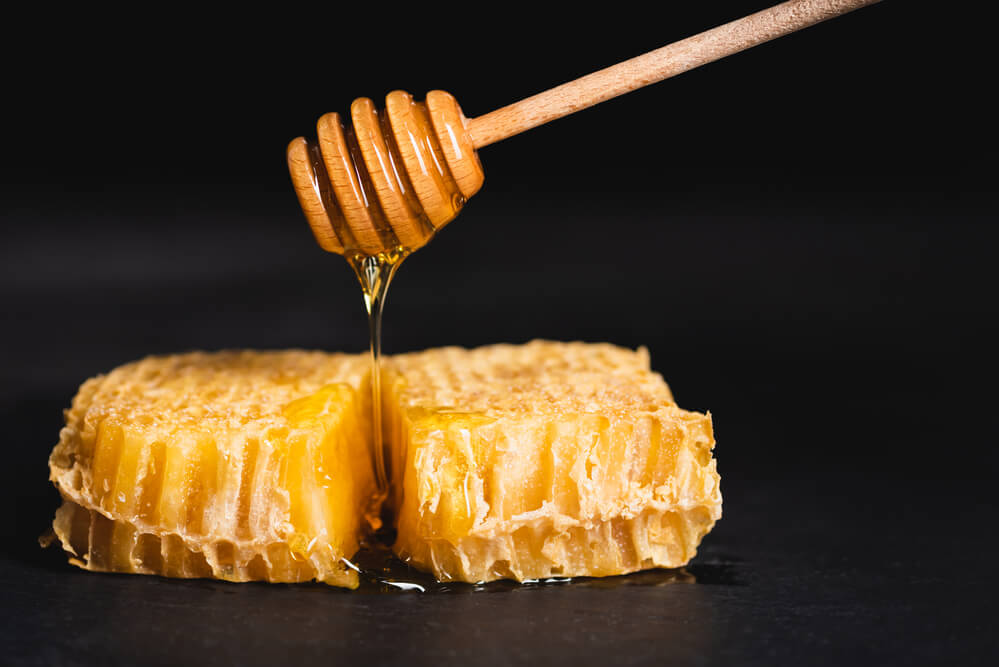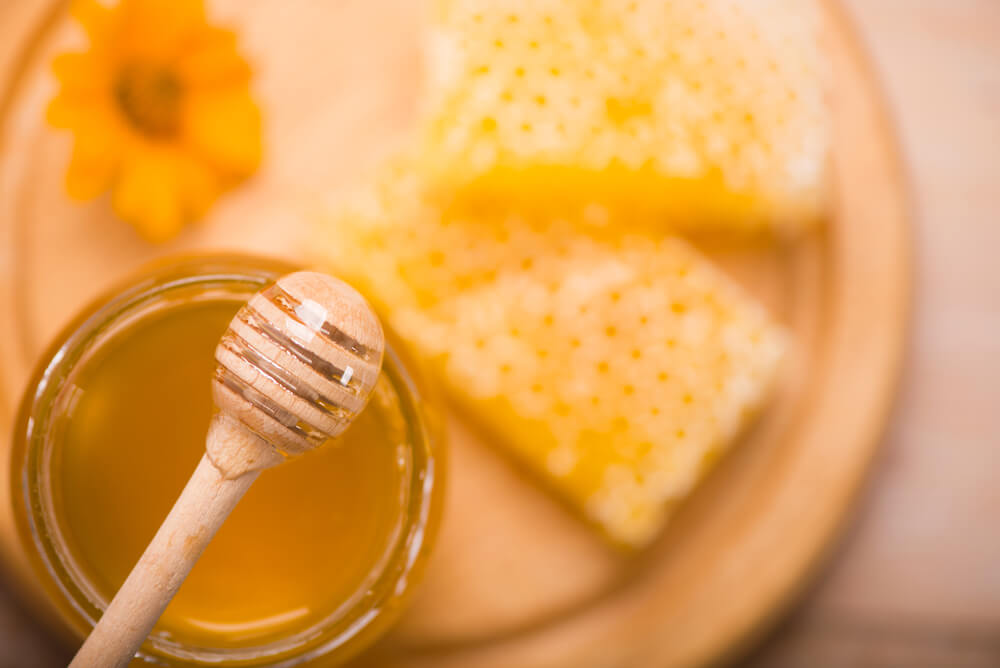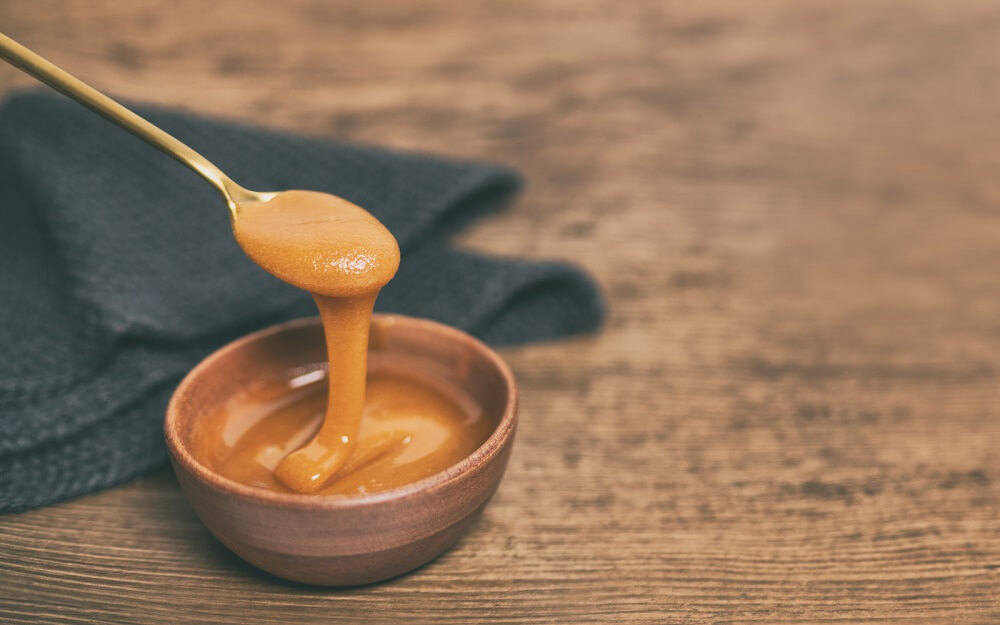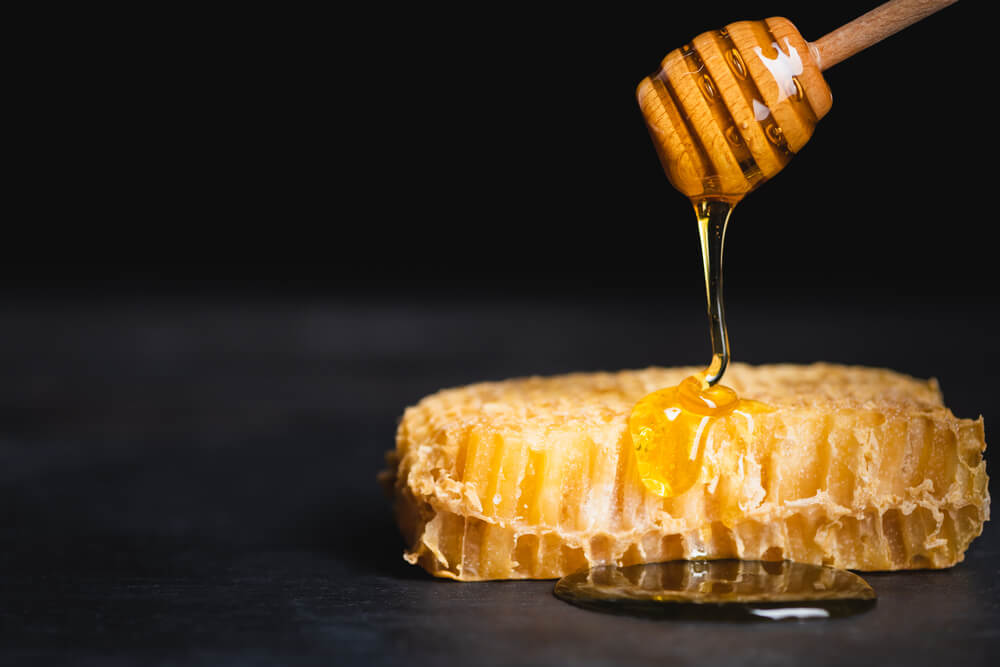Table of Contents:
What is Leatherwood Honey?

Leatherwood honey, also called Tasmanian honey, is produced by honeybees that feed on leatherwood flowers.
The leatherwood tree is native to Tasmania. Their white flowers produce lots of sweet nectar that entices honeybees.(1)
And here’s the thing:
Leatherwood honey is very rare.
In fact, the leatherwood tree only blooms for six to eight weeks out of the year. As a result, many beekeepers camp in the Tasmanian forests during the honey harvesting season. This gives the beekeepers the best chance to collect fresh leatherwood honey.
But what does leatherwood honey taste like?
One word:
Unique.
Raw leatherwood honey isn’t like anything you’ve tried before. It has a mildly sweet yet smoky taste, with subtle spicy undertones. The texture is thick and creamy, making it spread nicely on warm biscuits or toast.
More importantly:
True leatherwood honey only comes from the wet forests in Tasmania. But leatherwood flowers only bloom for a few weeks, so this honey is in limited supply.
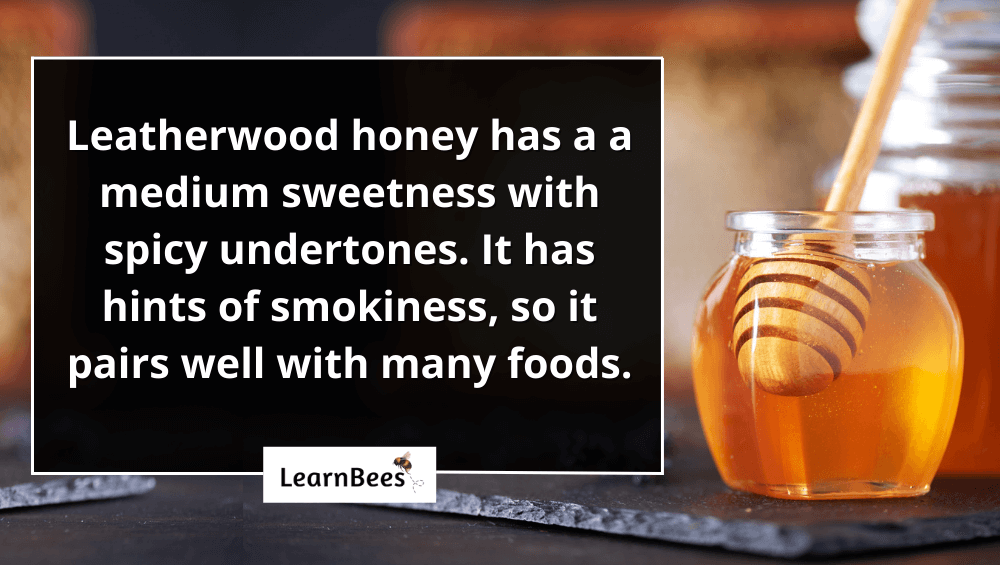
Now here’s the thing:
Honey is known for being antibacterial, antifungal, and anti-inflammatory. As such, honey has been used in clinical settings to treat everything from upper respiratory infections to serious wounds.
But keep in mind:
These health benefits only come from raw honey.
Raw leatherwood honey hasn’t been heated or pasteurized. It’s the purest form of honey straight from the beehive.
Why does this matter?
Because some honey suppliers process honey to the point where it’s no longer considered authentic honey.
When honey is heated during the pasteurization process, it loses some of its beneficial enzymes and antioxidants. Because of this, processed honey loses many of its health benefits.(2, 3)
And even worse:
Processed honey often gets diluted with artificial sweeteners such as sugar or high fructose corn syrup. As a result, the FDA warns that overly processed honey is no longer considered genuine honey.(4)
As for raw honey?
It’s left just the way the honeybees made it. It hasn’t been filtered, heated, or diluted with other ingredients.
So here’s our recommendation:
If you want both the unique taste and health benefits of honey, raw leatherwood honey is the way to go.
And as a general rule?
Always search for honey labels that say “raw” on them. Skip the plastic bear containers that have processed honey.
What Are the Benefits of Leatherwood Honey?
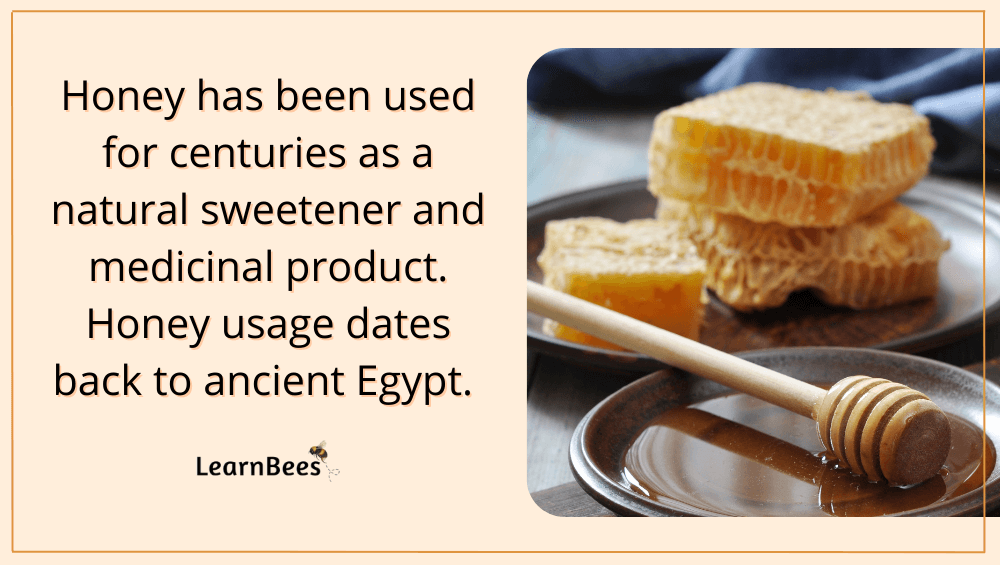
Honey has been a staple for over 3,000 years.
In fact, honey usage dates back to ancient Mayan civilizations, where it was used for everything from a natural sweetener to a cement mixture to a topical wound dressing.
But remember:
There are more than 300 varieties of honey.
Common examples include clover honey and tupelo honey. However, we don’t have clinical research on every type of honey because there are so many of them.
That said, raw honey as a whole has been linked to several health benefits due to its antibacterial, antifungal, and anti-inflammatory properties.
So let’s discuss a few:
Benefit 1: Raw Honey is a Good Source of Antioxidants
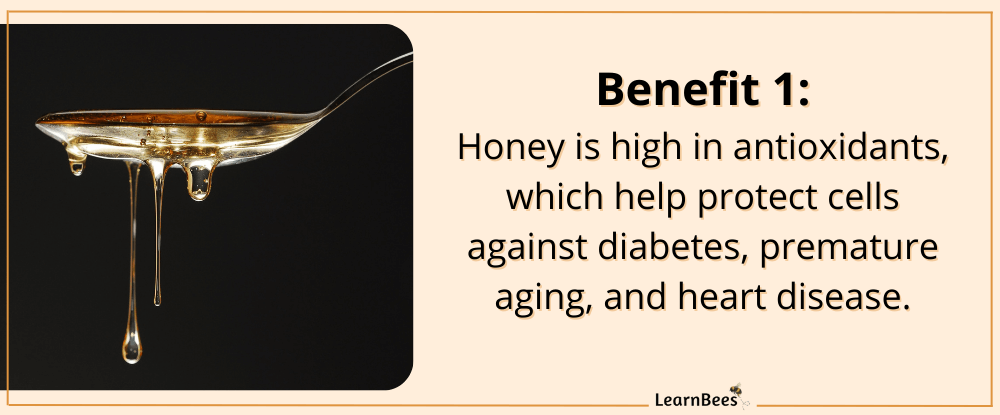
Honey is a good source of antioxidants, such as flavonoids and phenolic acids. These antioxidants help to protect the body from cell damage. Cell damage may result in conditions such as premature aging, type 2 diabetes, and heart disease.(5)
Raw honey contains antioxidants that may help protect against various illnesses linked to oxidative stress.(6)
Honey may also include pollen and bee propolis, providing additional health benefits. According to one study, raw honey may benefit the respiratory, gastrointestinal, cardiovascular, and neurological systems.(7)
Benefit 2: Raw Honey is Useful for Healing Wounds
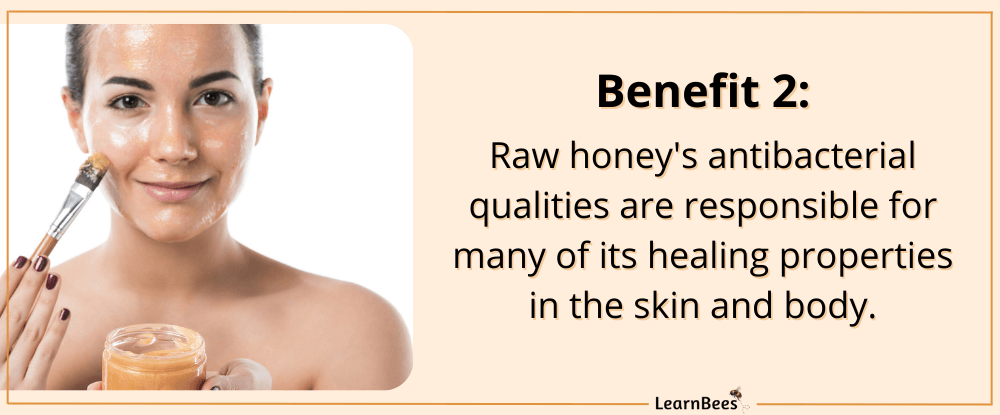
The use of topical honey for wounds is popular since it’s anti-bacterial, antifungal, and anti-inflammatory.(8)
Honey has been found to aid in healing burns and surgical wounds that have become infected after surgery.(9)
Honey has antimicrobial effects, according to a review of studies. Honey has also been shown to have anti-inflammatory properties.(10, 11)
Honey can be beneficial in the treatment of diabetes-related foot ulcers. Diabetic ulcers are serious and can lead to amputation.
In one study, honey had a 43.3% success rate for treating diabetes-related foot ulcers. Honey was also discovered to heal 97% of diabetes-related ulcers in a separate study.(12)
Additionally, it may help treat other skin conditions such as psoriasis and herpes lesions.(13)
Benefit 3: Raw Honey Can Improve Heart Health

Raw honey has been shown to help lower the risk of heart disease in a few studies.
In one study, 4,500 people who regularly consumed honey had reduced their high blood pressure.(14)
Honey has been shown in scientific studies to improve blood fat levels, regulate your heartbeat, and reduce blood pressure. As a result, this promotes better overall heart health.(15)
Honey was also shown in a rat study to help protect the heart against oxidative stress.(16)
Propolis, a resin produced by honeybees from sap-producing trees, is also found in raw honey. Propolis has been shown to have cholesterol-lowering and triglyceride-lowering effects.(17)
Benefit 4: Raw Honey Can Relieve Coughs and Sore Throats

Coughing is a symptom of people with respiratory infections, and it can have an impact on the quality of their sleep. Luckily, raw honey is an effective treatment option.(18)
One study on cough and honey found that honey is more effective than diphenhydramine (a cough medicine ingredient) for soothing coughs.(19)
What’s more, honey can reduce coughing fits.
Raw honey has been shown in several studies to be effective at treating upper respiratory infections.(20)
According to one study, it’s also improved sleep quality in children and their parents suffering from coughs.(21)
Honey has none of the adverse effects associated with some cough medications. That said, honey should not be given to infants less than one year old because of the risk of infant botulism.(22)
What Are the Risks of Leatherwood Honey?
Most adults can eat honey with no problems. Both honey and honeycomb are popular honey products.
But are there any side effects of leatherwood honey?
There are two risks you need to be aware of:
Risk 1: Raw Honey Can Pose Problems to Babies under 12 Months
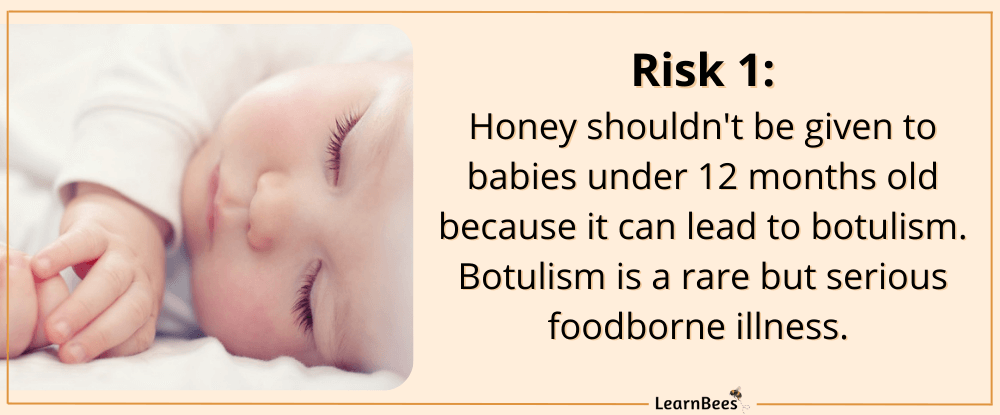
Children younger than one-year-old should not eat honey because it could lead to infant botulism.
Botulism is a rare but potentially fatal illness caused by Clostridium botulinum bacteria. The condition causes damage to the nerves and can lead to paralysis or death.
Babies are the most likely to get sick from botulism if they eat honey. This is because they don’t have a strong immune system that can fight the bacteria.
With that said, children over 12 months old can safely enjoy honey.
Risk 2: Raw Honey Can Spike Blood Sugar Levels in Diabetics

If you have diabetes or are at elevated risk, you’ve probably heard that honey is healthier than other sweeteners.
Even though honey has health benefits, it is still a source of sugar and carbohydrates. If you have diabetes, you need to monitor the carbs you eat throughout the day, especially when taking insulin.
Honey and sugar will cause your blood sugar level to rise, so they should be eaten in moderation.
FAQs on Leatherwood Honey
- What color is leatherwood honey?
- How do you take leatherwood honey?
- Is leatherwood honey safe?
- Is leatherwood honey better?
- What does leatherwood honey taste like?
- Where does leatherwood honey come from?
- Is leatherwood honey tea good?
- Is leatherwood honey for skin beneficial?
- Where can I buy leatherwood honey?
- Is leatherwood honey better than manuka honey?
- Is leatherwood a type of honey?
- Is leatherwood honey low GI?
- Did Gordon Ramsey eat Tasmanian leatherwood honey?
What color is leatherwood honey?
Leatherwood Tasmanian honey is a medium golden color. It isn’t white like some clover honeys, and it isn’t dark like buckwheat honey.
—> Go back to the FAQs on leatherwood honey
More to Explore:
How do you take leatherwood honey?
You can take leatherwood honey any way you want! You can eat it straight off the spoon, put it in your tea, or bake with it. My favorite way to eat leatherwood honey is to put it on toast with almond butter.
—> Go back to the FAQs on leatherwood honey
More to Explore:
Is leatherwood honey safe?
Yes, leatherwood honey is safe for most people. The only people who shouldn’t eat leatherwood honey are infants under 12 months old. Babies under 12 months old can get infant botulism from leatherwood honey.
Infant botulism is an uncommon but potentially fatal condition caused by Clostridium botulinum bacteria. It causes damage to the nerves and can lead to paralysis or death.
People with diabetes should also be careful when eating leatherwood honey because it can cause your blood sugar level to rise.
—> Go back to the FAQs on leatherwood honey
More to Explore:
Is leatherwood honey better?
People often ask:
Is raw leatherwood honey good for you? Is leatherwood honey healthy? What are the leatherwood honey benefits?
Yes, raw leatherwood honey has health benefits. Leatherwood honey is rich in antioxidants and has anti-inflammatory, cholesterol-lowering, and triglyceride-lowering effects.
With that in mind:
The benefits of honey come from raw honey. Raw honey is honey that hasn’t been heated, pasteurized, or processed in any way.
So, if you’re looking for the health benefits of honey, make sure you’re buying raw honey.
—> Go back to the FAQs on leatherwood honey
More to Explore:
- The Top 3 Best Manuka Honey Brands
- Orange Blossom Honey: Uses, Benefits, & Risks
- Sourwood Honey: Uses, Benefits, & Risks
What does leatherwood honey taste like?
Leatherwood honey tastes slightly earthy with a mild sweetness. It has subtle spicy undertones. It doesn’t have an overwhelming sweetness like certain kinds of honey. The flavor is unique and unlike anything you’ve ever tried from the grocery store.
It has a thick and creamy texture that spreads well on toast or bagels.
—> Go back to the FAQs on leatherwood honey
More to Explore:
Where does leatherwood honey come from?
People regularly ask, “What tree does leatherwood honey come from?”
Leatherwood honey comes from the flowers of the leatherwood tree. The leatherwood tree is native to Tasmania and grows in damp forest areas.
—> Go back to the FAQs on leatherwood honey
More to Explore:
- The Brutally Honest Truth About Sour Honey
- Buckwheat Honey: Uses, Benefits, & Risks
- Can You Eat Honeycombs?
Is leatherwood honey tea good?
Leatherwood honey in tea is a great way to relax and enjoy the unique flavor of the honey. Just add a spoonful of honey to your favorite tea and enjoy. The honey will quickly dissolve in hot tea.
—> Go back to the FAQs on leatherwood honey
More to Explore:
Is leatherwood honey for skin beneficial?
Leatherwood honey has many benefits for the skin. It’s naturally anti-inflammatory and can help soothe psoriasis, eczema, and other skin conditions.
Leatherwood honey is also a natural humectant, which helps keep skin hydrated and moisturized.
—> Go back to the FAQs on leatherwood honey
More to Explore:
Where can I buy leatherwood honey?
People frequently ask:
Where can I get leatherwood honey for sale? What’s the best Tasmanian leatherwood honey?
If you want genuine leatherwood honey from Tasmania, we recommend buying this brand. You can’t get leatherwood Tasmanian honey from your local grocery store because it’s rare honey in limited supply.
—> Go back to the FAQs on leatherwood honey
More to Explore:
Is leatherwood honey better than manuka honey?
Both manuka honey and leatherwood honey offer health benefits because they’re rich in antioxidants and enzymes. However, there haven’t been any clinical trials comparing the benefits of the two.
Manuka honey is more widely available than leatherwood honey, so it may be easier to find manuka honey. But manuka honey is also very expensive compared to other types of honey.
With that in mind, there isn’t any scientific research suggesting that manuka honey is healthier than other types.
People often ask, “What is special about leatherwood honey?” or “What makes leatherwood honey so good?”
Leatherwood honey is unique because it only comes from leatherwood trees found in the remote forests of Tasmania. The honey has a distinct flavor that is unlike any other honey.
—> Go back to the FAQs on leatherwood honey
More to Explore:
- What is Longan Honey?
- Do Honey Pasteurization Ruin Honey?
- Honey For Allergies: Is it a Potential Cure?
Is leatherwood a type of honey?
Yes, leatherwood honey is a type of honey that comes from the flowers of the leatherwood tree. The leatherwood tree is native to Tasmania and grows in damp forest areas.
Leatherwood trees only bloom for six to eight weeks per year, so leatherwood honey is rare honey that is only produced in small quantities.
—> Go back to the FAQs on leatherwood honey
More to Explore:
- Honey for Skin Benefits: Directions, Uses, & Risks
- 8 Scientific Benefits of Raw Honey
- Allergic to Honey: Signs of a Honey Allergy + Treatment
Is leatherwood honey low GI?
Some reports suggest that leatherwood honey has a lower glycemic rating than other types of honey. However, we haven’t found any credible scientific studies proving the GI of leatherwood honey.
As a result, people with diabetes should eat leatherwood honey in moderation.
—> Go back to the FAQs on leatherwood honey
More to Explore:
Did Gordon Ramsey eat Tasmanian leatherwood honey?
Yes, Gordon Ramsey visited Tasmania and tasted leatherwood honey in his show Uncharted.
He made a special trip to the forest where the leatherwood trees grow. When he was there, he visited a Tasmania beekeeper and tasted leatherwood honey directly from the honeybee hive.
Gordon Ramsey remarked on the unique flavor of leatherwood honey, saying it was mildly sweet with spicy undertones. He said he was interested in trying it in his cooking.
You can watch the clip of Gordon Ramsey here:
